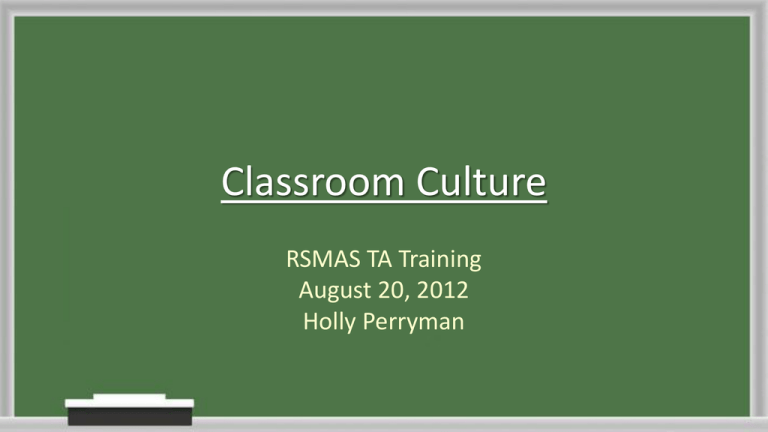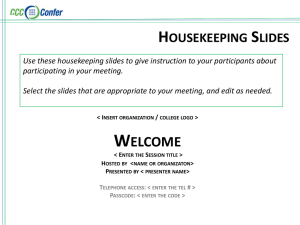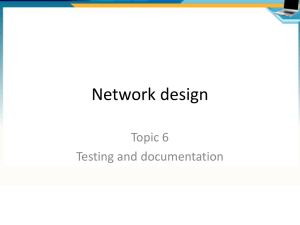Classroom Culture
advertisement

Classroom Culture RSMAS TA Training August 20, 2012 Holly Perryman 2 Classroom Culture What is it? • The process of instilling certain universal values and behavioral expectations in your student to: – Promote their well-being – Facilitate learning – Ensure future success Classroom Culture What is it? Why is it important? • The process of instilling certain universal values and behavioral expectations in your student to: • A classroom culture of trust and acceptance is the foundation for establishing an environment which students are empowered and comfortable with: – Promote their well-being – Facilitate learning – Ensure future success – Providing feedback – Learning from mistakes – Aiming to maximize potential How is Classroom Culture Developed? Establish a culture of acceptance and trust by: – Model acceptance and respect as students offer ideas to improve the classroom culture or learning – Act upon students’ suggestions to reinforce the value of student input – Encouraging students to participate and engage in process thinking and active listening How is Classroom Culture Developed? Establish a culture of acceptance and trust by: – Model acceptance and respect as students offer ideas to improve the classroom culture or learning – Act upon students’ suggestions to reinforce the value of student input – Encouraging students to participate and engage in process thinking and active listening Promote Active Listening by: – Promote student participation: asking volunteers / pick students randomly – Individual group responses (e.g., Students answer questions with provided answer cards) Building and Maintaining a Positive Learning Environment • Be prepared for each class and dress appropriately • Establish relationships with the class by attending class and learning & using the student’s names • Be consistent with expectations stated on syllabus – If you make changes, tell the class and provide a rational • Begin class by “grounding”, a brief introduction to transition the class to the days lesson – Announcements/A funny story/etc. Building and Maintaining a Positive Learning Environment • Get everyone’s “voice in the room”; promotes active listening – “What do we talk about last time” – “Discuss with your neighbor thoughts/questions/problems with the reading” • Think about lesson objectives and how to appropriately get them across – Maybe changing venues would facilitate the lesson • Encourage student interaction with you and each other Building and Maintaining a Positive Learning Environment • Frequently ask for student input – At the end of class, have students write down feedback on a piece of paper for various questions, e.g., “What went well today?”, “How was the pace?” – Show the students you are reading and considering their feedback (e.g., take a minute the next lecture to talk about their comments) • Provide closure with every lesson – For example: “Next time we will…”, “Please read …”, etc. Culture in the Classroom • The system of shared – Beliefs – Values – Customs – Behaviors – Artifacts Culture in the Classroom • The system of shared – Beliefs – Values – Customs – Behaviors – Artifacts • • • To engage students, reach out to them in ways that are culturally and linguistically responsive and appropriate Be aware of the cultural assumptions/stereotypes brought into the classroom that may hinder interconnectedness Develop an appreciation for diversity an promote equality and mutual respect among students Culture in the Classroom • The system of shared – Beliefs – Values – Customs – Behaviors – Artifacts • • • To engage students, reach out to them in ways that are culturally and linguistically responsive and appropriate Be aware of the cultural assumptions/stereotypes brought into the classroom that may hinder interconnectedness Develop an appreciation for diversity an promote equality and mutual respect among students Common Cultural Misunderstandings • Students not making eye contact – A sign of respect in some cultures • Students who may have limited English may avoid speaking, so nod and smile to indicated understanding – They may not be understanding at all • Students may refrain from speaking – A sign of respect in some cultures Common Cultural Misunderstandings • Students not making eye contact – A sign of respect in some cultures • Students who may have limited English may avoid speaking, so nod and smile to indicated understanding – They may not be understanding at all • Students may refrain from speaking – A sign of respect in some cultures • Personal space • Working in groups Vs. working individually – Culturally acquired learning style to “mimic” / see what has been done • Attitudes about time – Make your attitude obvious the first day General Strategies • • • • Recognize any biases or stereotypes you may have absorbed Treat each student as an individual, and respect each student for who he/she is Do your best to be sensitive to terminology Rectify any language patterns or case examples that exclude or demean any groups General Strategies • • • • Use terms of equal weight when referring to parallel groups Use both he and she during lectures, discussions and writing, and encourage students to do the same Recognize that your students may come from diverse socioeconomic backgrounds Refrain from remarks that make assumptions about your student’s experiences/backgrounds/family/religion/ etc. • • • • Recognize any biases or stereotypes you may have absorbed Treat each student as an individual, and respect each student for who he/she is Do your best to be sensitive to terminology Rectify any language patterns or case examples that exclude or demean any groups Lessons • Why classroom culture is important and how to incorporate it into your lecture • Promoting active listening as well as a positive learning environment • Embracing culture in the classroom and acknowledging common misunderstandings • General strategies for avoiding stereotyping Sources http://www.montgomeryschoolsmd.org/info/baldrige/staff/classroomculture.shtm http://tilt.colostate.edu/tips/tip.cfm?tipid=136 http://www.shenet.org/arongen/sfarenell/P12.htm http://www.tolerance.org/activity/culture-classroom http://www.tolerance.org/activity/test-yourself-hidden-bias www.pbisaz.org/files/CultureintheClassroom_06..ppt http://www2.honolulu.hawaii.edu/facdev/guidebk/teachtip/diverse.htm http://www.ajarn.com/blogs/steve-schertzer/creating-classroom-culture/ https://implicit.harvard.edu/implicit/demo/selectatest.html http://nadabs.tripod.com/culture/ Classroom Culture RSMAS TA Training August 20, 2012 Holly Perryman











